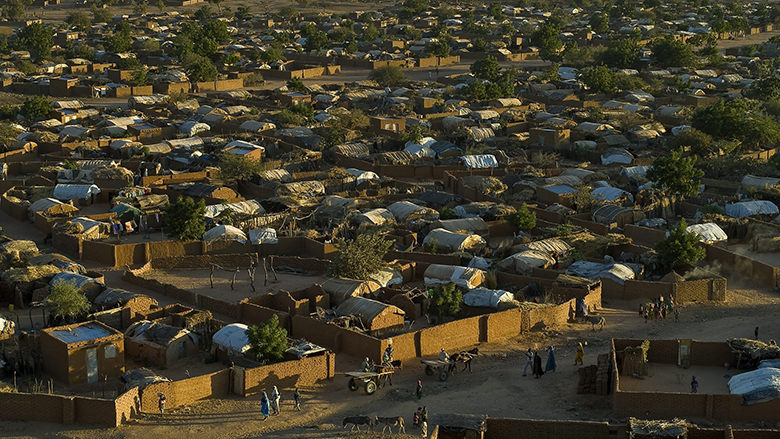WASHINGTON, May 9, 2017 – Of the more than 65 million people worldwide who had been forced from their homes due to conflict and generalized violence, women, youth and children accounted for at least two-thirds of the displaced population, according to a recent World Bank analysis of data on forced displacement.
The analysis, Stocktaking of Global Forced Displacement Data – supported by the German Federal Ministry for Economic Cooperation and Development and conducted in coordination with the German Institute for International and Security Affairs – provides a review of the various sources of data on refugees and internally displaced persons (IDPs) fleeing conflict and violence, and assesses how these can be improved to more accurately inform development policy and programming. The study also focuses on the need to appropriately tailor development responses to fragile, conflict-affected and violent situations, as well as the underlying drivers of conflict.
“Using data to establish an accurate picture of the scale and dynamics of forced displacement is extremely challenging, but we are working with partners to identify and address gaps and deficiencies,” said Xavier Devictor, Advisor, Fragility, Conflict and Violence Group, who manages the global forced displacement program. “This analysis is part of a broader effort to improve data overall on forced displacement for longer-term development planning.”
Led by the United Nations High Commissioner on Refugees (UNHCR) and Statistics Norway, national statistics agencies are working together to improve forced displacement statistics, a process that began at the 46th session of the UN Statistical Commission in March 2015. The current initiative focuses on refugees, asylum-seekers and IDPs. The World Bank is supporting this process.
According to the study, as of the end of 2015, there were 40.8 million internally displaced persons (IDPs), 16.1 million refugees, and 3.2 million asylum-seekers under the mandate of UNHCR, and 5.2 million Palestinian refugees under the United Nations Relief and Works Agency for Palestine Refugees in the Near East (UNRWA), the highest total on record since global forced displacement data started being collected in the early 1990s.
Historical Trends and Patterns
A review of available UNHCR data show there has been an unprecedented increase in the numbers of displaced people globally over the last decade, which can mostly be explained by a few historical conflicts:
- South Asia, Middle East – prolonged conflict in Afghanistan and Iraq, as well as the more recent Syrian crisis
- Africa – persistent conflict and instability in Burundi, DRC, Somalia and Sudan
- Latin America – four decades of internal armed conflict in Colombia
- Europe and Central Asia – the legacy of wars in the Caucasus, wars in Azerbaijan and the former Yugoslavia
By the end of 2015, while almost all countries in the world were hosting refugees, the burden was unevenly shared, the report notes. Turkey, Lebanon, and Jordan accounted for 27% of total refugees, while Pakistan and the Islamic Republic of Iran accounted for 16%. Ethiopia, Kenya and Uganda accounted for 11% of the world’s refugees. The report also notes that the majority of displaced people are hosted by developing countries, with almost 60% of IDPs and 30% of refugees in fragile and conflict-affected situations – underscoring a significant imbalance in the burden of hosting refugees.
Additional historical trends include:
- Since 1991, the same 15 countries, overwhelmingly in the developing world, have hosted more than 50% of refugees and asylum-seekers
- By the end of 2015, while almost all countries in the world were hosting refugees, the burden was unevenly shared:
- Turkey, Lebanon, and Jordan accounted for 27% of total refugees from Syria
- Pakistan and the Islamic Republic of Iran accounted for 16% of refugees from Afghanistan
- Ethiopia, Kenya, Uganda accounted for 11% of refugees from Somalia and South Sudan
- Forced displacement is an increasingly urban phenomenon, with approximately half of the world’s displaced known to be living in cities and towns, compared with a quarter in rural areas
- In Sub-Saharan Africa, displaced populations are still largely living in rural settings, but given the projected increase in urbanization globally, it is likely that in the future increasing numbers of displaced will seek refuge in cities and towns
- At the end of 2015, approximately 24% of all displaced people were adult women, and 51% youth and children under 18
Options to Improve Forced Displacement Statistics
The report notes that significant efforts are needed to improve the reliability, comparability, quality and scope of global data on forced displacement, and to address the data gaps needed for development planning. Some of the gaps can be addressed by mainstreaming household surveys using international survey instruments, the report says, and more innovative tools and technologies for data collection, analysis and compilation should be explored and leveraged.
Among others, additional report recommendations include:
- Harmonization of definitions and methodologies used in the collection and analysis of statistical data on forced displacement, in support of the process led by the UN Statistical Commission
- Improved coverage and detailed data on displaced populations living outside of organized camps
- Better aggregation, analysis and presentation of forced displacement data currently complied separately by UNHCR, International Organization for Migration (IOM), Internal Displacement Monitoring Centre (IDMC) and UNRWA
- Estimates of the size of affected host populations and data on the impact of displacement on host communities
- Rigorous impact assessments of interventions in various contexts to address the development impacts of forced displacement
Last Updated: May 16, 2017
